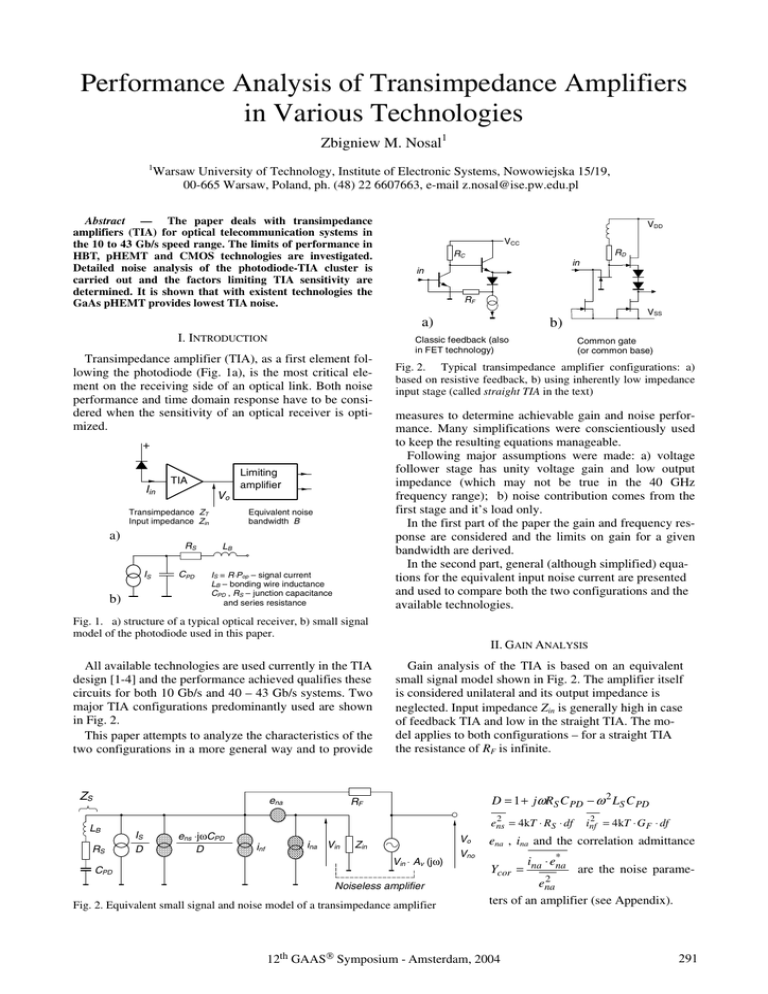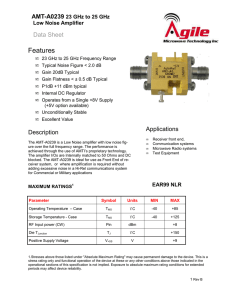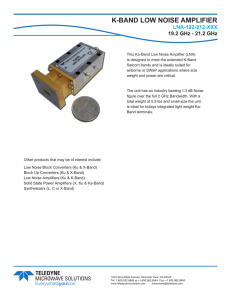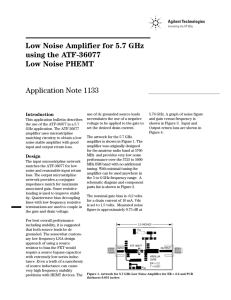GAAS: Performance Analysis of Transimpedance
advertisement

Performance Analysis of Transimpedance Amplifiers in Various Technologies Zbigniew M. Nosal1 1 Warsaw University of Technology, Institute of Electronic Systems, Nowowiejska 15/19, 00-665 Warsaw, Poland, ph. (48) 22 6607663, e-mail z.nosal@ise.pw.edu.pl Abstract — The paper deals with transimpedance amplifiers (TIA) for optical telecommunication systems in the 10 to 43 Gb/s speed range. The limits of performance in HBT, pHEMT and CMOS technologies are investigated. Detailed noise analysis of the photodiode-TIA cluster is carried out and the factors limiting TIA sensitivity are determined. It is shown that with existent technologies the GaAs pHEMT provides lowest TIA noise. VDD VCC RD RC in in RF VSS a) I. INTRODUCTION Transimpedance amplifier (TIA), as a first element following the photodiode (Fig. 1a), is the most critical element on the receiving side of an optical link. Both noise performance and time domain response have to be considered when the sensitivity of an optical receiver is optimized. + Iin Limiting amplifier TIA Vo Transimpedance ZT Input impedance Zin Equivalent noise bandwidth B a) RS IS b) CPD LB IS = R⋅Pop – signal current LB – bonding wire inductance CPD , RS – junction capacitance and series resistance b) Classic feedback (also in FET technology) Common gate (or common base) Fig. 2. Typical transimpedance amplifier configurations: a) based on resistive feedback, b) using inherently low impedance input stage (called straight TIA in the text) measures to determine achievable gain and noise performance. Many simplifications were conscientiously used to keep the resulting equations manageable. Following major assumptions were made: a) voltage follower stage has unity voltage gain and low output impedance (which may not be true in the 40 GHz frequency range); b) noise contribution comes from the first stage and it’s load only. In the first part of the paper the gain and frequency response are considered and the limits on gain for a given bandwidth are derived. In the second part, general (although simplified) equations for the equivalent input noise current are presented and used to compare both the two configurations and the available technologies. Fig. 1. a) structure of a typical optical receiver, b) small signal model of the photodiode used in this paper. II. GAIN ANALYSIS All available technologies are used currently in the TIA design [1-4] and the performance achieved qualifies these circuits for both 10 Gb/s and 40 – 43 Gb/s systems. Two major TIA configurations predominantly used are shown in Fig. 2. This paper attempts to analyze the characteristics of the two configurations in a more general way and to provide ZS ena LB RS CPD IS D ens ⋅jωCPD D Gain analysis of the TIA is based on an equivalent small signal model shown in Fig. 2. The amplifier itself is considered unilateral and its output impedance is neglected. Input impedance Zin is generally high in case of feedback TIA and low in the straight TIA. The model applies to both configurations – for a straight TIA the resistance of RF is infinite. D = 1 + jωRS C PD − ω 2 LS C PD RF 2 ens = 4kT ⋅ RS ⋅ df inf ina Vin Zin Vin ⋅ Av (jω) Noiseless amplifier Fig. 2. Equivalent small signal and noise model of a transimpedance amplifier Vo Vno 2 inf = 4kT ⋅ G F ⋅ df ena , ina and the correlation admittance Ycor = * ina ⋅ ena are the noise parame2 ena ters of an amplifier (see Appendix). 12th GAAS Symposium - Amsterdam, 2004 291 General expression for circuit transimpedance (Fig. 2) is ZT = Vo Av ⋅ R F = I S D ⋅ (1 − Av + R F Yin ) + jωC PD R F (1) Noise current density referenced to input (IS source terminals) inin = Vno / ZT is computed as e inin = D⋅ inf + ina + na ⋅ (1+ RF YS ) + jωC PD ⋅enS RF (2) In case of no-feedback configuration – like common base input stage – general expressions for ZT and inin are Av ZT = (3) D ⋅ Yin + jω C PD inin = D ⋅ ina + (ena + enS ) ⋅ jω C PD (4) gm⋅Vin Vin RB Gin Cπ common base/gate stage a) ri Vin b) Cµ RD V1 Cµ 1⋅V1 voltage follower Cµ Gin Cπ V gm⋅V common emitter/source stage RD V1 Cµ 1⋅V1 voltage follower A) fT = 50 GHz, B = 10 GHz, CPD = 0.2 pF, RS = 30 Ω. B) fT = 100 GHz, B = 10 GHz, CPD = 0.2 pF, RS = 30 Ω. C) fT = 160 GHz, B = 40 GHz, CPD = 50 fF, RS = 20 Ω. Transistor fT may easily be achieved with existing bipolar, HEMT or CMOS technologies and case A may be representative for a 0.25 µm CMOS, case B for a 0.13 µm CMOS and case C for a 90 nm CMOS [9]. When LB is included into the circuit, the transimpedance is given by the fourth order equation: Z T ( jω ) = where RD (1 + jω a )⋅ (1 + jω b − ω 2 c − jω 3d ) C PD 1 + +τ a Gin ωT L C d = B PD a = τ a = 2 RD C µ c= τa + LB C PD ωT ωT Equation (6) has been solved for the three cases considered for a range of transistor gm values. Assumption was made that transistor dimensions are kept constant and gm is changed by appropriate adjustment of transistor current. Cµ was taken as 15 fF for cases A and B, and 10 fF for case C. Resulting RD values are plotted in Fig. 4 with solid lines. Eq. (7) was used next to find numerically maximum RD and suitable inductance LB to achieve required bandwidth B. Additional constraint was imposed on the frequency response to be monotonic, without any significant peaks. This requirement is needed to assure adequate response in time domain and sufficiently clean eye diagram plot. The results are shown in Fig. 4 with dashed lines. Fig. 3. Simplified small signal equivalent circuit of an amplifier for a straight (a) and feedback (b) configuration. RB is a bias resistor for the input transistor. Relatively small Gin in b) may be neglected at higher frequencies. Transimpedance vs. gm 900 A B C A_LB B_LB C_LB 800 700 where Cµ = Cbc or Cgd . Substituting (5) into (3) the expression for ZT may be derived in case of LB = 0. This will allow evaluating inherent limitations for this configuration. ZT is given by RD 1 ⋅ (6) Z T ( jω ) = 2 1+ jω τ a ω τD C PD 1 + jω + +τ D 1− ωT Gin ωT where the time constants are: τa = 2RDCµ and τD = RSCPD , and Gin = gm , ωT ≈ gm /(Cπ + Cµ ). This equation sets the limit on the transimpedance ZT (0) = RD given the photodiode and transistor parameters. For a given bandwidth B an upper limit for the allowable time constant τa may be found and hence the RD value for a certain transistor size and technology. Next, the gain limits will be derived for three illustrative sets of transistor and photodiode parameters for 10 Gb/s and 40 Gb/s transmission: 292 600 ZT (Ohm) The two cases will be dealt with separately. For the straight (no-feedback) circuit the voltage gain may be approximated to the first order as Ao g m RD Av ( jω ) = = (5) 1 + jωτ a 1 + jω ⋅ 2 RD C µ (7) b= B = 10 GHz 500 400 300 200 100 40 GHz 0 0 25 50 75 100 125 150 gm (mS) Fig. 4. Transimpedance vs. first transistor gm for the three cases considered. Solid lines – circuit without LB , dashed lines – for inductive compensation. Similar considerations were carried out for a feedback TIA. Relevant equations are given below. For LB = 0 − RF 2C C R 1+ jω τ D +RF C µ + PD F −ω 2 RF C µ τ D + PD g m RD gm For LB ≠ 0 − RF ZT = (8) 1 + jωa − ω 2 b − jω 3 c ZT ≈ 12th GAAS Symposium - Amsterdam, 2004 where C PD RF g m RF 2C b = LB C PD +RF C µ τ D + PD gm a = τ D + RF C µ + c = LB C PD RF C µ It is interesting to note that to the first order the response does not depend on transistor fT assuming that Cµ is consistent with required bandwidth. The major pole is formed by the feedback resistor RF and the photodiode capacitance. Analysis similar to the presented above has been performed and the results are presented in Fig. 5 for B = 10 GHz and in Fig. 6 for the bandwidth B = 40 GHz. It was assumed that the load resistance RD needed might be achieved with appropriate circuitry (passive or active). Transimpedance vs. gm - BW = 10 GHz 1400 A_10 a) gm = 20 mS, RD = 550 Ω Fig. 7. Eye diagram plots: a) for B = 10 GHz and monotonic response, b) for circuit with too low input impedance and B = 13.8 GHz. 10 Gb/s NZR signal. III. NOISE ANALYSIS General expressions for the input current noise density are given by (2) and (4). Noise sources ena and ina include contributions from the first transistor, its load and possibly from the bias resistor RB (Fig. 8). enT A_20 1200 A_30 ZT (Ohm) 1000 ALB_10 RB ALB_20 800 inB inT ALB_30 Transistor [Y] RD inL 600 Fig. 8. Noise sources in the amplifier stage. enT and InT characterize first transistor 400 200 The noise sources ena and ina are given by 0 0 25 50 75 gm (mS) 100 125 150 Fig. 5. Transimpedance vs. transistor gm for the three cases and B = 10 GHz. Solid lines – circuit without LB , dotted lines – for inductive compensation. Results for the voltage gain gmRD = 10 , 20 and 30 are shown. Transimpedance vs. gm - BW = 40 GHz 800 C_10 700 C_20 C_30 600 CLB_10 ZT (Ohm) b) gm = 150 mS, RD = 880 Ω 500 4kTdf 1 4kTdf y11 ina =inB + inT + RD y 21 RD y 21 CLB_30 300 (9) Simple expressions were adopted for transistor noise description [2, 3, 5]: For a bipolar transistor: IC enT = 4kT ⋅ rb⋅ df inT = 2q + I B df (10a) β ( jω ) For a CMOS transistor: Γ df enT = 4kT ⋅ rG + g m CLB_20 400 ena = enT + inT = 4kT Γ⋅ (ω CG ) 2 df gm (10b) For a HEMT transistor: 200 100 0 0 25 50 75 gm (mS) 100 125 150 Fig. 6. Transimpedance vs. first transistor gm for the three cases and B = 40 GHz. Solid lines – circuit without LB , dashed lines – for inductive compensation. It may be noticed that the feedback circuit provides approximately 2 times more gain than the straight TIA under comparable conditions. LB inductor in general allows increasing the gain at a given bandwidth, although the compensation is feasible over a relatively narrow range of gm values. Particularly in a straight configuration, the low input impedance (at high gm ) causes peaking in the frequency response and corresponding distortion of the eye diagram (see Fig. 7). 2qI D ⋅ Cn + 4kT ( RG + RC ) df enT = ⋅ gm 2q I D ⋅ C n ⋅ (ω CG ) 2 df inT = gm (10c) where: CG is the total gate to channel capacitance, RG is gate resistance, RC is a part of a channel resistance under the gate and Cn is the fitting coefficient [5]. Appropriate correlations were taken into account. Input noise current density is given below. For a non-feedback amplifier: 2 2 2 2 2 2 inin = D ina + ω 2C PD ena + enS + * + 2 Re − D ⋅ ina ena ⋅ jω C PD 12th GAAS Symposium - Amsterdam, 2004 (11) 293 For amplifier with feedback: use of their high gm. 2 2 2 2 2 2 2 2 inin = D inf + ina + ω C PD ena + enS + * 2 Re − D ⋅ ina ena ⋅ jω C PD (12) Equations (11) and (12) show the significance of the photodiode capacitance – it is important to use the diode with the lowest possible CPD in high sensitivity systems. Selected results of analysis are shown in Fig. 9 and 10. Only feedback TIA is presented here as the straight configuration has higher noise, because: transistor input voltage noise is somewhat higher, gain (and hence RD is lower and additional contribution from input RB. Input noise current density - pHEMT-RF = 700Ω IV. CONCLUSIONS Of the two major configurations of transimpedance amplifiers the feedback TIA (Fig. 2a) provides higher gain at given bandwidth and with the same transistors used. In terms of transimpedance gain, the existing technologies (CMOS, HEMT and bipolar) have comparable capabilities. In terms of sensitivity, (equivalent input noise current) HEMT transistors give best results. APPENDIX Two-port noise figure F vs. source impedance YS may be expressed as 16 Tr_only 14 Tr+RF Inin (pA/Hz) T_RS=0 10 D 8 ( in − en ⋅ YS )2 (A.1) 4 kT0 ⋅ GS ⋅ df introducing correlation admittance and equivalent noise resistance RN and conductance GN C All 12 F (YS ) = 1 + Ycor = Gcor + jBcor = 6 B 4 in2 = 4kT0G N df 2 A 0 0 2 4 f (GHz) 6 8 in en* en2 (A.2) en2 = 4kT0 R N df the two-port noise parameters are given by (A.3) 10 Fig. 9. Components of the total input referred noise current: A – contribution from transistor only, B – transistor and feedback resistor, C – all components, D – noise from photodiode RS excluded Input noise current density - RF = 700 Ω, LB = 1nH Bsopt = Bcor G 2 2 Gsopt = N − Bcor RN (A.3) Fopt = 1 + 2 R N (Gsopt − Gcor ) 18 pHEMT 16 CMOS CMOS 14 pH_noLB 12 Inin (pA/Hz) REFERENCES HBT HB_noLB 10 CMO_noLB 8 6 pHEMT 4 2 0 0 2 4 f (GHz) 6 8 10 Fig. 10. Input noise current density for a pHEMT, SiGe HBT and CMOS feedback amplifiers. Solid lines: no LB correction, dotted lines: with LB = 1 nH. In each case: fT = 100 GHz, gm = 25 mS, RF = 700 Ω In Fig. 10, three technologies were compared for a particular case of a 10 GHz feedback circuit. Representative transistor parameters were taken from publications [4, 6, 8] and all other factors were kept equal. As may be expected the lowest noise is achieved with the pHEMT devices. Results for 40 GHz TIAs are similar in nature. When the noise properties are considered under supply power restrictions, the lowest noise at a given bias current is achieved with SiGe and InP bipolar devices, beca- 294 [1] J.S. Weiner et al., "SiGe differential transimpedance amplifier with 50 GHz bandwidth", IEEE J. Solid-State Circuits, vol. 38, pp. 1512-1517, Sep. 2003. [2] R.A. Fratti, Kai Hui, “A 73 GHz, 180 ohm PHEMT transimpedance amplifier, employing gm tapering, for OC768 optical receivers”, 2004 IEEE MTT-S Internattional Microwave Symp. Digest, Fort Worth, TX, pp. 813-816, June 2004. [3] R. Tao et al.,”Wideband truly differential CMOS transimpedance amplifier”, Electronic Letters, vol. 39, no. 21, Oct. 2003. [4] Z.M. Nosal, T.P.E. Brokaert, "InP HBT transimpedance amplifier for 43 Gb/s optical link applications, " 2003 IEEE MTT-S International Microwave Symp. Digest, Philadelphia, PA, 8-13.06.2003, p. 117-120. [5] D. Guckenberger, K. Kornegay, "Novel low voltage, low power, Gb/s transimpedance amplifier architecture", Prcoc. SPIE, vol. 5117, pp. 274-285, 2003. [6] Z. Nosal, "Design of GaAs MMIC transistors for the lowpower low noise applications", 2000 IEEE MTT-S International Microwave Symp. Digest, Boston, MA, pp. 13-16, June 2000. [7] D. Becher et al., “Noise performance of 90 nm CMOS technology”, 2004 IEEE MTT-S International Microwave Symp. Digest, Fort Worth, TX, pp. 17-20, June 2004. [8] D. R. Greenberg, "SiGe HBT noise performance", 2004 IEEE MTT-S International Microwave Symp. Workshops, Fort Worth, TX, June 2004. 12th GAAS Symposium - Amsterdam, 2004




